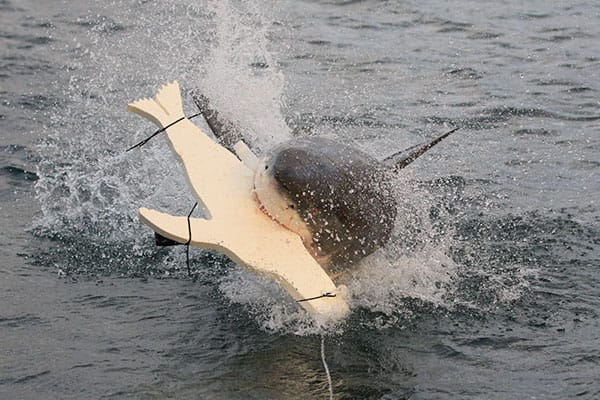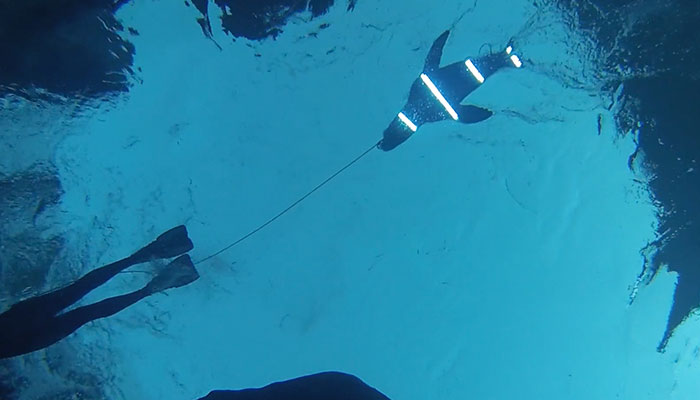Lights deter Great White sharks: new research
These researchers have previously discovered that great whites place a high reliance on their eyes to locate prey.

First published by Macquarie University
VIDEO: What if surfers could be protected from shark attacks with something like an invisibility cloak? That’s what Professor Nathan Hart says is close to happening following discoveries he and colleague Dr Laura Ryan have made about how to trick sharks’ visual systems.
In a new paper titled Counterillumination reduces bites by Great White Sharks just published in the journal Current Biology, Dr Ryan, Professor Hart and their fellow authors say their work “may form the basis of new non-invasive shark deterrent technology to protect human life”.
Video credit: Pow Wow Pictures
These researchers have previously discovered that great whites place a high reliance on their eyes to locate prey. They spot something near the surface - typically a seal - and lunge upwards to take it in their jaws.
In related studies, the researchers have also found that, like most sharks, great whites are probably completely colour blind and have poor visual acuity. But they have a way to compensate. “They are really good at detecting a silhouette,” says Dr Ryan.
But unfortunately the shark’s poor vision means that, to them, the silhouette of a surfboard or a human in the water looks similar to a seal - which is a key reason why great whites pose such a danger to people.
However the great white shark’s reliance on seeing the silhouette of their prey also opens up an opportunity. What if a silhouette on the surface of the water was disguised using lights so that the shark - blind to colour and unable to detect detail - would not see it as food?
Tests in shark-laden waters
To test out this counterillumination strategy Dr Ryan spent months, in multiple trips over six years, in one of the world’s notorious hot spots for great white sharks - Mossel Bay in South Africa.
She and her colleagues towed 1.2m long, seal-shaped foam decoys on a 20m line behind a boat and saw the decoys regularly attacked by great whites. But they also experimented with using LED lights, in different configurations, to break up the silhouette of the decoys.

Covering the whole of the underside of the seal decoy in bright lights was found to work very well in deterring sharks. But using so many lights was not energy efficient and it would be expensive and impractical to apply to surfboards.
They also tried flashing lights, which strobed four times a second, but that proved not to be effective.
After much experimentation they found the ideal pattern to fool the sharks was to place the lights in stripes across the bodies of the seal decoys, perpendicular to the direction they were being towed through the water.
The sharks still saw the decoy, but its shape was broken up and the great whites stopped attacking.
“It’s like an invisibility cloak but with the exception that we are splitting the object, the visual silhouette, into smaller bits,” says Professor Hart. “It’s a complex interaction with the shark’s behaviour. The lights have to be a certain pattern, a certain brightness.”
Can surfers relax now?
The team also tried longitudinal stripes of LED lights, but these were less effective. “When you have the lighting going along the body, you still have a long, narrow silhouette left over, which is going to be similar to what a seal produces,” says Dr Ryan.
Will the system work to protect surfers? The study did not specifically test the effectiveness of lights mounted under surfboards because the South African authorities, understandably, wouldn’t agree to using surfboard shaped decoys to lure great white sharks to attack. It might have created greater danger for surfers.
But there’s no reason why the system won’t work on surfboards. “What we’re trying to do now is move from seal decoys into a surfboard prototype by embedding LEDs into the bottom of a surfboard,” says Dr Ryan.
They are also doing further research to test whether LED lights will still deter great whites when a surfboard is stationary in the water, such as when a surfer is waiting for a wave.
It’s not surprising that the counterillumination strategy is successful in deterring predators because it copies something already used by many marine creatures. For example, in their paper Dr Ryan and Professor Hart point to the juvenile plainfin midshipman fish which has photospores on its underside that produce light and disrupt the shape of its silhouette.
Neither is it surprising that the striped pattern works well to confuse great white sharks. “Striped body patterns are common in nature and are thought to be a form of disruptive camouflage that make it harder to detect the shape or outline of an animal,” the paper says.

Will the lights work to deter other shark species? Dr Ryan and Professor Hart are going to find out. While great whites are responsible for most shark attacks on humans, bull sharks and tiger sharks also pose a major threat.
Dr Ryan says they have started testing the light system with these species. “We don't know if it will be as effective on them because we're not certain if they rely on visual cues as much as white sharks,” she says.
And even though they believe they have convincing “proof of concept” that striped lights are effective in deterring great white sharks, they plan on doing more work before surfers are encouraged to adopt the counterillumination strategy to keep them safe in the waves.
“We suggest further experiments are required before counterillumination should be deployed for shark mitigation to protect humans,” their paper says.




